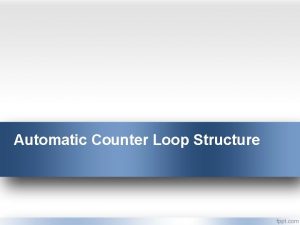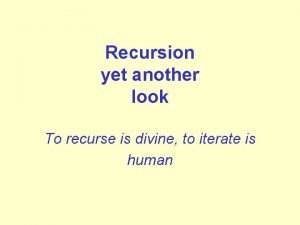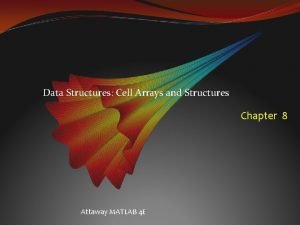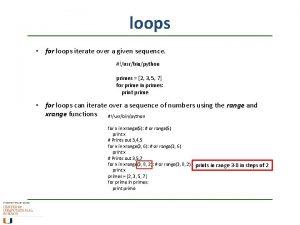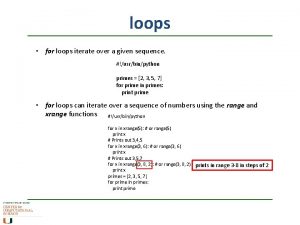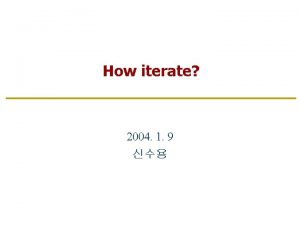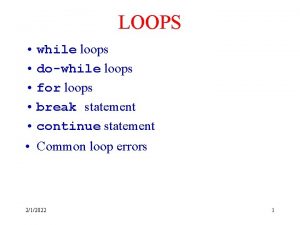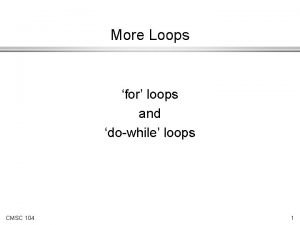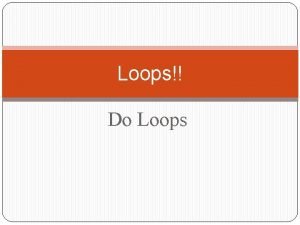loops for loops iterate over a given sequence








- Slides: 8

loops • for loops iterate over a given sequence. #!/usr/bin/python primes = [2, 3, 5, 7] for prime in primes: print prime • for loops can iterate over a sequence of numbers using the range and xrange functions #!/usr/bin/python for x in xrange(5): # or range(5) print x # Prints out 3, 4, 5 for x in xrange(3, 6): # or range(3, 6) print x # Prints out 3, 5, 7 for x in xrange(3, 8, 2): # or range(3, 8, 2) prints in range 3 -8 in steps of 2 print x primes = [2, 3, 5, 7] for prime in primes: print prime

while loops • while loops repeat as long as a certain boolean condition is met. #!/usr/bin/python # Prints out 0, 1, 2, 3, 4 count = 0 while count < 5: print count += 1 # This is the same as count = count + 1

while loops, break, continue • while loops repeat as long as a certain boolean condition is met. #!/usr/bin/python # Prints out 0, 1, 2, 3, 4 count = 0 while count < 5: print count += 1 # This is the same as count = count + 1 • break is used to exit a for loop or a while loop. • continue is used to skip the current block, and return to the for or while statement #!/usr/bin/python # prints out 0, 1, 2, 3, 4 #!/usr/bin/python # Prints out only odd numbers - 1, 3, 5, 7, 9 count = 0 while True: print count += 1 if count >= 5: break for x in xrange(10): # Check if x is even if x % 2 == 0: continue print x

functions • Functions in python are defined using the block keyword def, followed with the function's name as the block's name. #!/usr/bin/python function w/o argument def my_function(): print "Hello From My Function!” def sum_two_numbers(a, b): return a + b my_function() x = sum_two_numbers(1, 2) print x function w argument(s) calling functions

dictionaries • A dictionary is a data type similar to arrays, but works with keys and values instead of indexes. • Each value stored in a dictionary can be accessed using a key, which is any type of object (a string, a number, a list, etc. ) instead of using its index to address it. phonebook = {} phonebook["John"] = 938477566 phonebook["Jack"] = 938377264 phonebook["Jill"] = 947662781 alternatively: phonebook = { "John" : 938477566, "Jack" : 938377264, "Jill" : 947662781 }

dictionaries contd. • Dictionaries can be iterated over, just like a list. However, a dictionary, unlike a list, does not keep the order of the values stored in it. To iterate over key value pairs, use #!/usr/bin/python phonebook = {} phonebook["John"] = 938477566 phonebook["Jack"] = 938377264 phonebook["Jill"] = 947662781 for name, number in phonebook. iteritems(): print name, phonebook #or for i in phonebook. keys(): print i, phonebook[i]

dictionaries contd. • To remove a specified index, use either one of the following notations: #!/usr/bin/python phonebook = {} phonebook["John"] = 938477566 phonebook["Jack"] = 938377264 phonebook["Jill"] = 947662781 del phonebook["John"] # or phonebook. pop("John") for name, number in phonebook. iteritems(): print name, phonebook

Classes and objects • Objects are an encapsulation of variables and functions into a single entity. Objects get their variables and functions from classes. Classes are essentially a template to create your objects. #!/usr/bin/python class My. Class: variable = "blah" def function(self): print "This is a message inside the class. ” myobjectx = My. Class() assign the above class(template) to an object • To access the variable inside of the newly created object "My. Object" you would do the following: print myobjectx. variable • To change the variable: myobjectx. variable = "yackity" print myobjectx. variable
